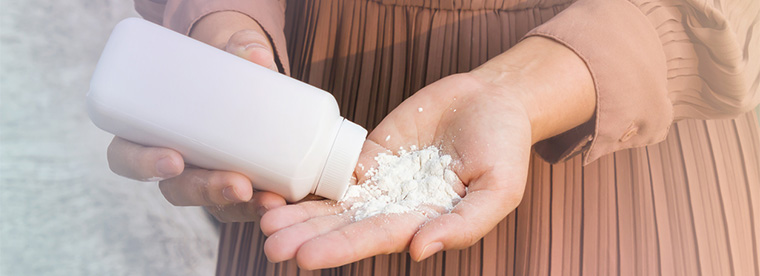What studies say about talcum powder and ovarian cancer
The possible link between ovarian cancer and talcum powder dates back to the 1960s. The initial concern sprung from a contamination of talcum powder with asbestos, a known cancer-causing agent. Asbestos is often mined alongside the mineral talc, which is the main ingredient in talcum powder. Asbestos was banned from cosmetic-grade talc in 1973, and the Food and Drug Administration reported finding no traces of asbestos in talc-based cosmetic products in 2012.
Recent studies looking at a potential link between talcum powder and ovarian cancer have been inconclusive. Some show a slightly increased risk, and others report no increase at all.
One problem with many of these studies is that they relied on people’s memory of their talcum powder use. Researchers asked women with ovarian cancer if they used talcum powder on their perineum and, if so, how long they had used it and how frequently. Memory is not always perfect.
A woman’s risk of developing ovarian cancer in her lifetime is 1.6 percent. Some studies suggest that risk rises to 1.8 percent with perineal talc exposure. That translates to 18 women out of 1,000 developing ovarian cancer instead of 16. While that may not sound like a lot, that’s two women who may not have gotten ovarian cancer if they had avoided talcum powder.
How I advise women about using baby powder on themselves and babies
While statistically the potential increased risk is very small, we want to do everything we can to reduce a woman’s risk for developing ovarian cancer. That’s why I recommend women not apply talcum powder on their sanitary napkins, diaphragms or directly to their genital area.
If you’ve used talcum powder for these purposes, even for years or decades, you don’t need to run to your doctor or get special testing. Instead, just stop using the product.
I advise patients who have or care for daughters in diapers to avoid talcum powder on them as well. While we know little for sure about the ovarian cancer risk to adults who use baby powder, we know even less about the potential risk to babies. If I had babies again, I probably would not use talcum powder on their bottoms. If you want an alternative, try dusting your baby or yourself with cornstarch instead.
When my patients ask if they should douche or use other vaginal hygiene products, I tell them that the vagina is designed just as it should be and should be messed with as little as possible. I don’t recommend the use of any artificial products that you don’t absolutely need. And if you do use them, find the product with the least number of additives, such as coloring or perfume.
Know the symptoms and other risk factors for ovarian cancer
Ovarian cancer is known as a “silent killer” because most women will not experience symptoms until the disease is advanced.
Symptoms of ovarian cancer can include:
- Abdominal or pelvic pain
- Bloating
- Difficulty eating or feeling full quickly
- Unexplained weight gain
These symptoms can be attributed to a variety of conditions, including normal body changes that occur during a woman’s menstrual cycle.
But if they suddenly appear and don’t go away, request an appointment with your doctor.
Request an Appointment
The main risk factor for developing ovarian cancer is age. The average age of a woman with ovarian cancer is 63. The older you get, the higher your risk for developing the disease.
The most commonly talked about ovarian cancer risk is familial risk, or a disease that runs in the family. While most ovarian cancers are not hereditary, family history certainly is very important. Genetic mutations, such as BRCA1 and BRCA2, account for about 15 percent of all ovarian cancers.
If a first-degree family member—parents, siblings or children—had ovarian cancer or breast cancer before age 50, you may want to consider seeing a geneticist to determine your potential risk. We include breast cancer because BRCA1 and BRCA2 mutations increase a person’s risk for multiple cancers, including breast and ovarian.
There’s nothing you can do about getting older or your genetic makeup, but you can do something about your weight, which is the No. 1 modifiable risk factor for ovarian cancer. If you are 25 pounds overweight, your ovarian cancer risk rises 400 percent. So while talcum powder may slightly increase your risk of ovarian cancer, it’s minimal compared to the risk of carrying extra weight.
We may never know for sure whether talcum powder absolutely can cause ovarian cancer, but not using it on your genital area is an easy way to avoid the potential risk. If you’re concerned about your risk for ovarian cancer, talk to your doctor. Together, you can work out a plan to manage your risk factors and feel comfortable with your feminine hygiene.

